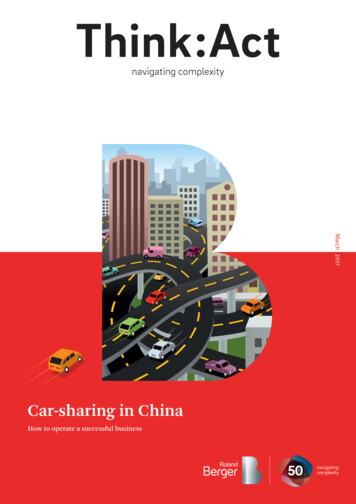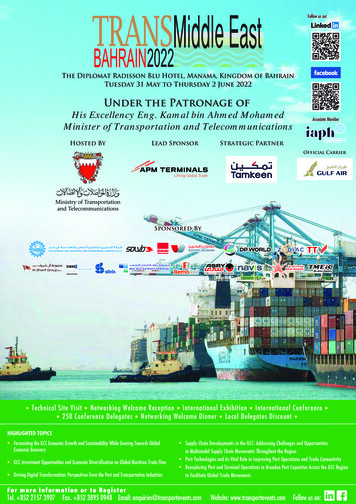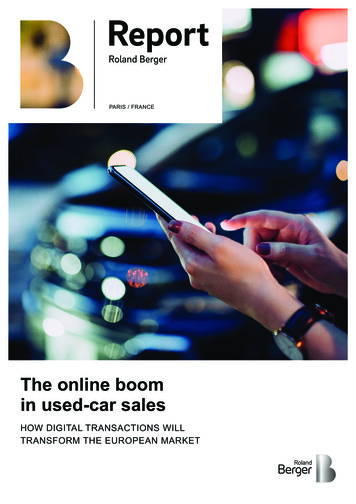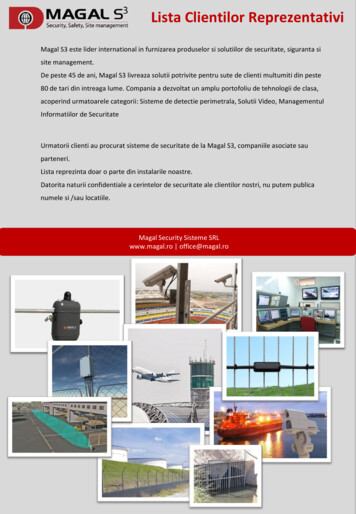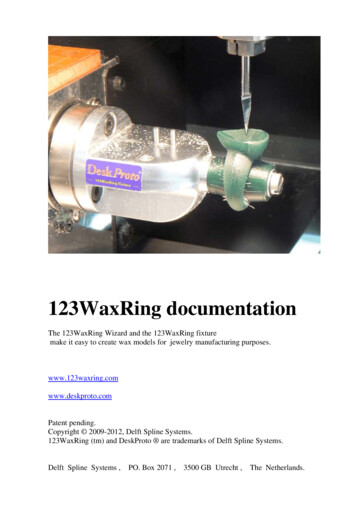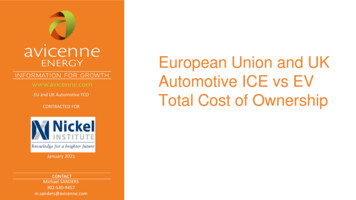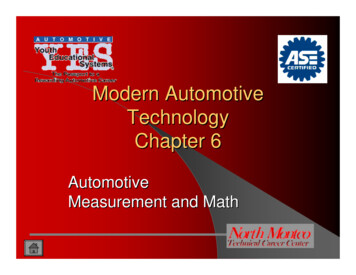
Transcription
STUDYIsrael's automotive andsmart mobility industryElectrified, autonomous and intelligentAuthors: Dr. Wolfgang Bernhart, Dr. Christian-Simon ErnstOctober 2018
2ISRAEL'S AUTOMOTIVE & SMART MOBILITY INDUSTRYElectrified, autonomous and intelligentTable of contents1. Management summary. 52. Introduction and methodological approach . 73. Disruptive trends in the automotive industry: Changes in the technological ecosystem . 83.1 E-mobility: Regulatory pressure on a developing market . 93.2 Autonomous mobility: A race between traditional automotive companies and new players 123.3 Smart mobility: Creating robust strategies in times of radical change . 153.4 Perspective for 2030: Control points within the technological ecosystem . 184. Israel's automotive and smart mobility industry . 204.1 Development of Israeli industry . 204.2 Technology competencies of selected Israeli startups . 264.2.1 E-mobility . 264.2.2 Autonomous mobility . 274.2.3 Smart mobility . 284.2.4 Conventional vehicle technology and other fields . 294.3 Israel's entrepreneurial ecosystem . 304.3.1 Finance . 314.3.2 Human capital. 324.3.3 Market. 344.3.4 Policy . 354.3.5 Support . 374.3.6 Culture . 394.4 Strengths and technology potential of Israeli industry . 405. Growth opportunities . 435.1 International growth opportunities for Israeli companies . 435.1.1 E-mobility . 435.1.2 Autonomous mobility . 445.1.3 Smart mobility . 445.1.4 Conventional vehicle technology and other fields . 445.2 Opportunities for international companies to invest in Israel . 455.2.1 Establish an R&D operation in Israel. 455.2.2 Buy technology and talent through M&As and strategic ventures . 465.2.3 Set up new platforms such as innovation labs and accelerators . 46
3ISRAEL'S AUTOMOTIVE & SMART MOBILITY INDUSTRYElectrified, autonomous and intelligent5.2.4 Use Israel as a base for managing your innovation activities . 475.2.5 Engage Israel's high-tech diaspora . 47
4ISRAEL'S AUTOMOTIVE & SMART MOBILITY INDUSTRYElectrified, autonomous and intelligentTable of figuresFigure 1: Key drivers of disruption in the mobility landscape . 8Figure 2: Key influencing factors and trends impacting the automotive industry . 9Figure 3: Drivers of global electrification scenarios . 10Figure 4: Share of propulsion types, 2020 and 2025 (high electrification scenario) . 11Figure 5: Summary of push factors for ADAS from governments and consumer protection bodies 13Figure 6: SAE definitions of levels of autonomous mobility . 14Figure 7: Launch horizon for automated driving functions . 14Figure 8: Overview of global mobility scenarios: possible futures in 2030 . 16Figure 9: Autonomous scenario: Estimated revenues and profits [EUR bn] . 17Figure 10: Critical control points for the 2030 technology ecosystem . 19Figure 11: Structure of the Israeli automotive and smart mobility industry . 21Figure 12: Overview of selected OEM/OES activities in Israel . 22Figure 13: Overview of recent activities in Israel . 23Figure 14: Evolution of Israeli automotive and mobility startups and their financing . 25Figure 15: Startups by development phase and capital-raising model . 26Figure 16: E-mobility: Examples of Israeli startups . 27Figure 17: Autonomous mobility: Examples of Israeli startups . 28Figure 18: Smart mobility: Examples of Israeli startups . 29Figure 19: Vehicle technology: Examples of Israeli startups . 30Figure 20: Israel's entrepreneurial ecosystem . 30Figure 21: Israel is a reliable investment region for financial partners . 31Figure 22: Israel's human capital . 33Figure 23: Technology-based market view . 34Figure 24: Overview of national R&D programs from the Office of the Chief Scientist . 36Figure 25: Overview of top-level state support . 37Figure 26: Overview of support . 39Figure 27: Key characteristics of Israeli entrepreneurs . 40Figure 28: Characteristics and success factors of the Israeli entrepreneurial ecosystem . 41Figure 29: Israel's activity radar for critical control points, by company maturity . 42Figure 30: Mastering critical control points guarantees future growth opportunities . 43Figure 31: Four ways to benefit from Israel's expertise . 45
5ISRAEL'S AUTOMOTIVE & SMART MOBILITY INDUSTRYElectrified, autonomous and intelligent1.Management summaryThe automotive industry is currently getting excited about possible disruptions arising fromtechnological and societal trends such as electric, autonomous and smart mobility. These trendsattack the very foundations of the business models employed by established players and existingsupplier structures. In particular, a new cultural behavior in which people "consume mobility" ratherthan buy cars could have a major impact on current players.Israel has recently become active in the automotive and smart mobility industry. Technologycompanies like Mobileye and Valens and mobility service providers such as Waze and Gett havetheir roots in Israel and are driving growth in this sector in the region. Historically, Israeli companiessupplied conventional mechanical parts to the automotive world. But more recently, the digitizationof mobility has demanded new competencies – such as object recognition and tracking foradvanced driver assistant systems, as well as mobility behavior projections for shared ride services.These are precisely the fields where Israel has developed specific skills in the past, often targetingmilitary defense applications or big data applications for intelligence services. These capabilities,which are very important for the future, are accessible to a large share of Israel's highly skilledworkforce. A growing awareness for the availability of these competencies is reflected by theincreasing investments and activities of automotive players of the caliber of GM, VW, Daimler, Ford,Renault-Nissan, Bosch, Samsung (Harman) and many others.One noticeable feature of the Israeli business landscape is the large number of entrepreneurs andsmall businesses that have focused on the above-mentioned technological trends in recent years.The cultural aspects that foster this development and motivate people to start a new business canbe summed up in a simple statement: "It is the Israeli dream to launch a startup." The businessculture is direct and somewhat confrontational: People are trained in out-of-the-box thinking duringtheir military service and develop a robust attitude toward failure and risk-taking. This combinationof characteristics results in a fast speed of business. Global venture capitalists have become awareof the potential of Israel's technology and IT startup scene and are increasingly investing in theregion. The country's tightly meshed business network culture allows easy access to investors,speeding up company development.Further growth in local businesses can be achieved by targeting the relevant technologies andinterfaces – or "critical control points" – in each technology sector. These interfaces are directlylinked to sharing in revenues in future business models that rely on the use of mobility. Israel's localindustry may indeed start growing faster, as many multinationals are excited by the innovationscoming from the region and are keen to participate or collaborate. Companies are investing in theregion through bilateral R&D partnerships, mergers and acquisitions, strategic ventures, setting upinnovation labs, or simply by connecting to the local scene to manage innovation areas.Overall, the Israeli automotive and smart mobility industry is becoming an innovation lab and pulsegenerator for the movements connected with electric, autonomous and smart mobility.
6ISRAEL'S AUTOMOTIVE & SMART MOBILITY INDUSTRYElectrified, autonomous and intelligentVoices from the automotive industry on IsraelIfanyone had any doubt, all you have to do is look at theMobileye transaction. Not just because of its unbelievable sizebut because of the fact that Intel has now moved their worldactivity in mobility to Israeli headquarters. In addition to the Intel“Israel is now a world leader in the autonomous vehicle market place.leadership, there are now approximately 500 different mobility startups andleading mobility funds in Israel."Jonathan Medved (OurCrowd)August 02, 2018 NoCamels““[in auto tech startups] a lot of theentrepreneurs are coming out ofthe Israel Defence Forces and theytend to be older than the traditionalSilicon Valley (entrepreneurs). Theyhave a lot of judgment and wisdom.We were not known as a country that providestechnology to the automotive industry andsuddenly you have more than 500different startups dealing with . theautomotive industry"Ziv Aviram (Mobileye)Particularly in areas like cybersecurity,there’s tremendous activity coming out ofIsrael.”May 23, 2018 Technology NewsBill Ford (Ford)country has a lot of scientific andtechnological potential in many areasthat are important for our company’sfuture, and we want to take advantageof that.Relative to its population, noother country is as innovative."May 23, 2018 Technology NewsDaimler board member Professor ThomasWeber, who also heads the conglomerate'sresearch and development ventures for cars,said the new technology center “seeks toboost the global R&D outline withthe help of Israel, the high-technation.so that we will continue tobe the automotive industry'stechnological leader in terms ofefficient, technologically advanced,safe cars.”It’s just the right environment for ground-breakinginnovations, and thus for Bosch as well. TheVolkmar Denner (Robert Bosch)June 22, 2016 Automotive World“There are a lot of areas in Israel that are going toplay a vital role in the automotive industry ; thereare likely to be more areas to which Israelientrepreneurs will bring the latest innovations.”Thomas Weber (Daimler)Uri Pachter (Faurecia)November 7, 2016 Globes - Israel BusinessNewsAugust 02, 2018 NoCamels“That’s why we don’t think or act like a normal VC fund.Our goal is not pure economic profit. A VC fund can doa lot to help young companies, but it can never be theirclient. We can, and after we invest in acompany, we start working together tointegrate its technologies into GM vehicles.”Lauckner, unsurprisingly, has a flattering view of theIsraeli tech scene, claiming “there are manycapabilities here that suit our needs.”Jon Lauckner (GM)April 19, 2016 Globes - Israel Business News“This opening is part of the Alliancepolicy on global presence upstream,in research and innovation alike.The dynamic environment inIsrael is an opportunity thatwill serve both to promotethe electric vehicle andfoster creativity on mobility.”Serge Passolunghi (Renault)June 14, 2016 auto.economictimes
7ISRAEL'S AUTOMOTIVE & SMART MOBILITY INDUSTRYElectrified, autonomous and intelligent2.Introduction and methodological approachOver the last two decades, there has been a significant increase in the number of Israeli startupsand companies operating in areas such as the shared mobility economy, fleet management, bigdata for transportation, connected vehicles, autonomous driving and e mobility. About 550 startupsare currently operating in these fields, while industry interest has been growing and investments inthe Israeli smart mobility sector reached USD 22 billion over the last five years. To take just oneexample: quick-charging battery startup StorDot alone received over USD 80 million in funding1during 2017-2018 .The objective of this report is to provide global stakeholders with an up to date professional analysisof the potential and opportunities created by the Israeli smart mobility industry.To gain a solid understanding of the industry, we conducted a first-hand analysis of the Israeli smartmobility industry, including looking at input from the Israel Export Institute as well as from the FuelChoices and Smart Mobility Initiative. We also held on-site meetings with companies, accelerators,venture capitalists and other industry leaders.The report is structured as follows:1.Key technological and commercial trends in the automotive and mobility sectorsThis section summarizes the current status and main trends in the industry, with a special focus onthe following subsectors: E-mobility Autonomous mobility Smart mobilityWe also identify critical control points within the technological ecosystem formed by thesesubsectors. The topic of smart mobility thus covers activities such as a) connected cars, b) urbanmobility, transportation and city logistics, c) shared mobility and d) big data applications. Ourfindings are based on a combination of extensive project work around the globe and RolandBerger's ongoing research activities.2.Israel's smart mobility technological landscapeThis section is based on a first-hand survey of Israel's smart mobility industry and overallentrepreneurial ecosystem. As well as carrying out desk research, Roland Berger spoke to morethan 25 people from startups, incubators and accelerators, ventures capitalists and policymakersabout the entrepreneurial ecosystem as a whole. Based on this overview, we then analyzed thecompetencies that exist within the region and the strengths of the Israeli smart mobility industrycompared to the global industry.3.Growth opportunitiesBased on our analysis of technology trends and the Israeli smart mobility landscape, we see anumber of opportunities for Israeli startups within the global trends. We also see opportunities formultinationals to invest in Israel's smart mobility industry.1Source: Crunchbase
8ISRAEL'S AUTOMOTIVE & SMART MOBILITY INDUSTRYElectrified, autonomous and intelligent3.Disruptive trends in the automotive industry: Changes in thetechnological ecosystemThe automotive and mobility ecosystem as we know it is set to change in the next decade. Drivenby disruptions such as the reprioritization of customer expectations and new, open ecosystems (forexample on the mobility level), new technological innovations are appearing – and with thembusiness model innovations.New industry entrants and established OEMs are fast developing advanced driver assistancesystems into holistic solutions that enable automated driving. Connectivity between systems,vehicles and infrastructure enables new functionality and smart traffic management. We are alsoseeing continuous development in powertrains: from more efficient conventional drives and the useof alternative fuels to powertrain electrification and long-distance electric driving using fuel cells.On the business model side, digital marketing is introducing consumers to a completely newownership experience and lifecycle, replacing the former "retail sales aftersales" concept. Theavailability of information and the possibilities for sharing information, generated by smartphonesand high-speed communications, open up new business models for smart advertising and sharingmobility. For example, customers will see advertisement depending on their mobility behavior andcan be linked to others to reduce their joint costs of mobility.Figure 1: Key drivers of disruption in the mobility landscapeMajor disruptions Reprioritizingcustomerexpectations &buying criteriaTechnological innovationAutomateddrivingConnectivity &smart devicesPowertraintechnology New and openecosystem Innovation inbusiness models Change in valuecenters Fast developmentcyclesDigitizationof retailDataintelligenceSharingeconomyBusiness model innovationSource: Roland BergerWe therefore need to evaluate the various factors driving the development of the automotiveindustry in terms of both their level of impact and their certainty. Future strategies must take intoaccount all possible developments within the industry. For example, events such as the recent"dieselgate" had a significant impact on the industry, yet were considered very unlikely only acouple of years ago.
ISRAEL'S AUTOMOTIVE & SMART MOBILITY INDUSTRYElectrified, autonomous and intelligentIn the following sections, we first focus on developments driven by customer demand, regulatorypressure and technological advances. E-mobility and autonomous mobility represent decisivechanges in the way vehicles are designed, built and used.Figure 2: Key influencing factors and trends impacting the automotive industryProgress in microelectronicsAutonomous drivingEmergence of new mobility(Level 4 City)playersCustomer acceptance ofCustomer pull/Technologicalregulatory pushnew mobility conceptspossibilitiesEmission regulationsDigitization of vehiclesales & distributionOverall GDPdevelopmentImpact9Growth of electric vehiclesConnectivityCity regulationsSmart products/devices/featuresUrbanizationDecline of dieselSafety regulationsDeclining role of carsas a status symbolNew lightweight materialsAssisted/automated driving(Level 1-3)UncertaintySource: Roland BergerLooking at these developments, we see further disruption potential on a higher level as peoplechange their day-to-day mobility behavior. Novel service solutions will emerge, driven bydigitization, increasing connectivity and new shared behaviors. This will have a fundamentalinfluence on the scenarios. The key challenge will be to occupy the critical points for future businessmodels.3.1 E-mobility: Regulatory pressure on a developing marketEnvironmental awareness is driven by events such as extreme weather phenomena and high fuelprices, which lead to high expenditure on mobility. Governments have recognized these widerdevelopments and are now focusing on shaping a sustainable individual mobility strategy thatencompasses resource conservation, environmental compatibility and safety. In response, OEMshave begun to build cleaner, safer and more diverse vehicles, including a variety of zero-emissionvehicles.The Kyoto Protocol and, more recently, the Paris Agreement, signed in 2016, represent majorachievements in the joint understanding of environmental protection. Both aim to reduce CO 2emissions significantly in the future. For developed countries, the Kyoto Protocol sets out theobjective of reducing emissions by 25-40 percent by 2020 (compared to 1990 levels) and by 80-952percent by 2050. The transportation sector is one of the main producers of CO 2 worldwide,2King, D.; et al. (July 2011), "Copenhagen and Cancun"
10ISRAEL'S AUTOMOTIVE & SMART MOBILITY INDUSTRYElectrified, autonomous and intelligentresponsible for 23 percent of all CO2 emissions in 2013 and second only to the energy industry (423percent).As a result, governments are pushing the automotive industry for cleaner vehicles. Fuel efficiencyand emission targets have been introduced to decrease CO2 and other emissions by bothpassenger and commercial vehicles, as shown in Figure 3.Figure 3: Drivers of global electrification scenarios2016EUUSAChina202020252030Push 130 g corporateCO2 target 95 g corporateCO2 target 75 g corporate CO2target (strictest) Long-term corporateCO2 target possiblePull Limited subsidies Limited subsidies First city accesslimitations for ICE Increasing city accesslimitations for ICE ICE ban in firstcountries possible Major city accesslimitations for ICE ICE bans TCO advantagePush CARB ZEV regulation CAFE standards CARB ZEV regulation CAFE standards New CARB ZEVregulation CAFE standards New CARB ZEVregulationPull Large subsidies Many innovators Large subsidies remain TCO advantage due tohigh mileage andbattery cost reduction TCO advantage due tohigh mileage andbattery cost reductionPush None 117 g corporateCO2 target 95 g corporate CO2target incl. strongreinforcements forforeign OEMs TBDPull Subsidies License-plateadvantages License-plateadvantages Large subsidies still License-plateadvantages City access limitations City access limitations License-plateadvantagesVery strong driver for shift toward e-mobilityWeak driver for shift toward e-mobilitySource: Roland BergerIn Europe, the current CO2 regime obliges the automotive industry to significantly reduce CO2 fleetemissions. In 2020, 95 percent of all vehicles will be allowed to emit just 95 g/km, compared to 130g/km in 2015. This corresponds to average fuel consumption of 3.5 l/100 km and is only achievedby a few vehicles today. As of 2020, the targets will need to be met by the entire European fleet ofnewly registered vehicles each year. The European target for 2020 is more challenging than inother markets, such as the USA and China. At the same time, the European Commission is alreadydiscussing plans to further increase efficiency in the area of transportation, with the possibleintroduction of a new set of targets for 2025 or 2030.In addition, many cities have restricted the use of vehicles to decrease emission levels in theirdowntown areas. London, for example, has imposed a congestion charge since 2003. In Germany,all vehicles are classified by emission level (green, yellow or red) and cities can prevent certainvehicle segments from accessing downtown areas (or restrict their access) if necessary. Europeancities such as Amsterdam, Paris and Oslo are pursuing similar ways of introducing inner-city tolls oreven discussing banning certain types of vehicle.In response to these political regulations, OEMs have improved their vehicles – especially theirpowertrains, which, besides vehicle mass, aerodynamics and overall power consumption, are one3Statista, 2013
11ISRAEL'S AUTOMOTIVE & SMART MOBILITY INDUSTRYElectrified, autonomous and intelligentof the main levers for cutting CO2 emissions. Alongside downsizing engines, powertrainelectrification is becoming more and more attractive as a way to meet future emissions goals andthe local requirements of cities.Figure 4: Share of propulsion types in 2020 and 2025 (high electrification scenario)Europe9%100%3%5% e100%2%4%15%9%100%12%35% 15%BEV10%100%4%4%2%PHEV8%BEV BEVs developingstrongly Declining role ofdiesel drivetrains10%2%PHEVHEVUnited line(incl. MH)10%DieselMHChina14%Diesel Demand for BEVs andPHEVs, especially inmegacities25%202090% Stronger focus on longdistance travel ability(PHEVs) Demand for BEVs,especially for California Strongest demand forfull hybrid20252020202520202025BEV: Battery Electric Vehicle; PHEV: Plug-in Hybrid Electric Vehicle; FH: Full Hybrid; MH Mild HybridSource: Roland BergerIn the long term, most vehicles will have an electrified drivetrain. Plug-in hybrid electric vehicles(PHEVs) and battery electric vehicles (BEVs) will represent the majority of new car registrationsglobally by 2030. While BEVs will replace conventional ICE-powered vehicles in megacities inparticular, fuel cell electric vehicles (FCEVs) will also start to penetrate the market and, togetherwith PHEVs, have a significant impact on long-distance electric driving. These technologies willbecome self-sustaining as an attractively priced alternative for many end-customers. They will alsobenefit from the trend toward shared mobility. This technology shift will be accelerated by strongregulatory action in the medium term, especially in Europe and China.In the meantime, new PHEV architectures for larger production volumes will enable initialeconomies of scale to be generated for electric traction. Manufacturers will develop and introducespecial modular PHEV architectures before 2025 as a cost-effective solution. This move will beprompted by increasing customer pull from Japan and some parts of North America, as well as bythe need to comply with future European and Chinese CO 2 fleet emission regulations. Both factorswill encourage the use of PHEVs. These architectures will leverage the full potential of strongelectric traction motors while bypassing the cost-driving functions in combustion engines, such asvariable valve lift, to improve partial loads. Future PHEVs will drive in purely electric mode at lowloads. They will also significantly simplify transmission, as they only require a few gear ratios. Also,BEVs and FCEVs will be integrated in these modular architectures and will benefit from growingeconomies of scale.The electrification of individual mobility is a key topic for sustainable transportation. One keysuccess factor is, therefore, mastering R&D in various areas:
12ISRAEL'S AUTOMOTIVE & SMART MOBILITY INDUSTRYElectrified, autonomous and intelligent Electric powertrain: The electric powertrain consists of a modest number of components,namely the electric motor and the corresponding power electronics. The current short-termfocus lies on permanent magnet synchronous motors (PMSM), despite their higher cost dueto high energy density and efficiency requirements. As battery costs come down, a strongerfocus will develop on cost, leading to the gradual adoption of externally excited synchronousmotors (EESM) and asynchronous motors (AM). In the long run, reluctance motors (RM) willadvance from the R&D stage to the market. Power electronics: The architecture of power electronics is evolving, as is the choice ofsemiconductor modules. A gradual evolution at the module level in terms of functionalintegration is expected through 2023, accompanied by a reduction in part complexity. Thenext generation will introduce dedicated insulated-gate bipolar transistors (IGBTs) and metaloxide semiconductor field-effect transistors (MOSFETS) for automotive applications. Insemiconductors, we will see the gradual introduction of silicon carbide over a relatively longoverlap period in which Si and SiC coexist. However, SiC-based power electronics requiresubstantial investments. Power electronics based on gallium nitride (GaNI) are currently notconsidered suitable for automotive applications. Batteries: Energy storage and management are crucial technological components for allkinds of electrified vehicles. The costs of Li-ion battery cells and the periphery are key forfuture developments in mass production. In addition, alter
Authors: Dr. Wolfgang Bernhart, Dr. Christian-Simon Ernst October 2018 . 2 ISRAEL'S AUTOMOTIVE & SMART MOBILITY INDUSTRY Electrified, autonomous and intelligent Table of contents . Berger's ongoing research activities. Electrified, autonomous and intelligent s & & Electrified, autonomous and intelligent 2 2
